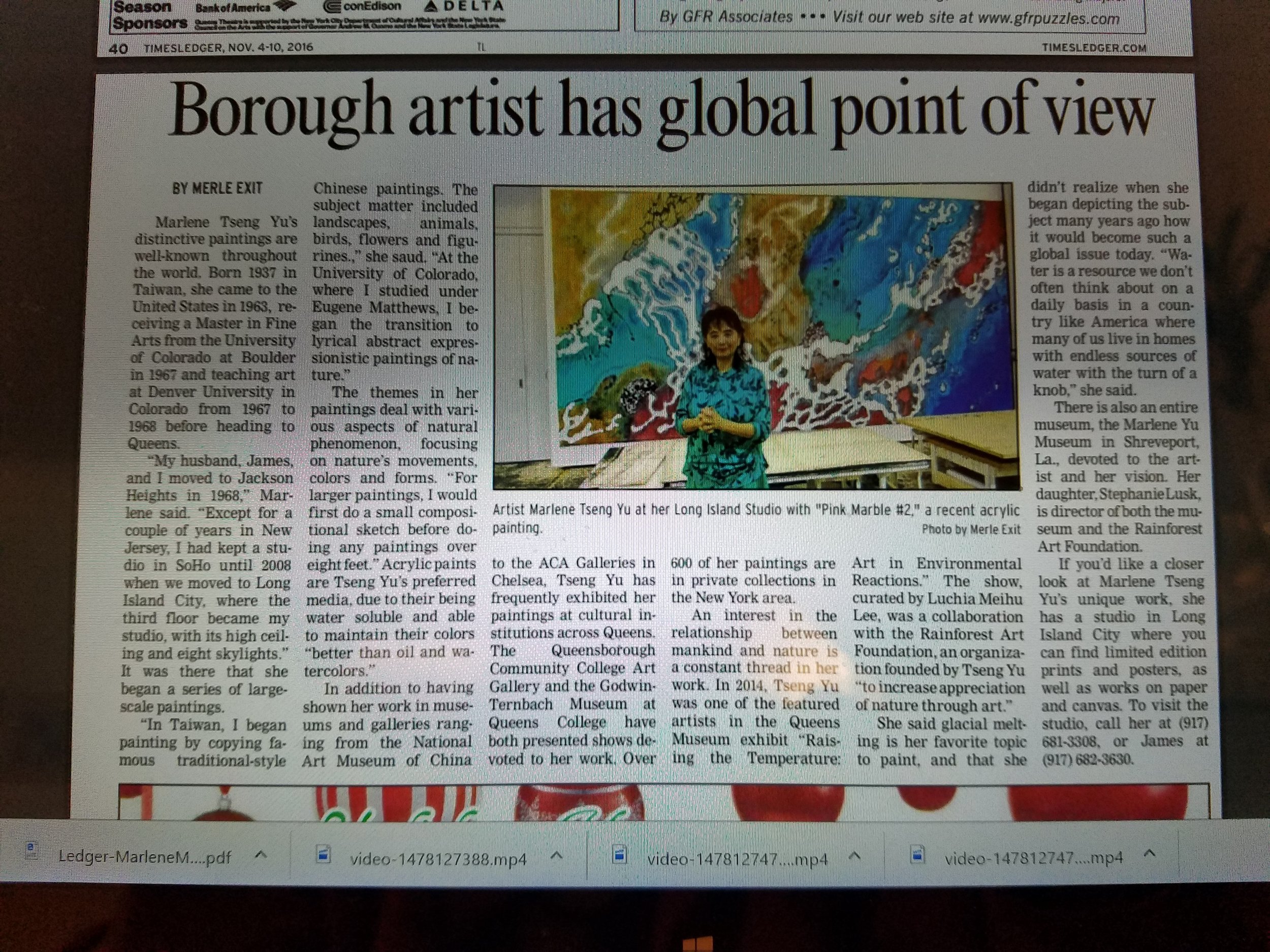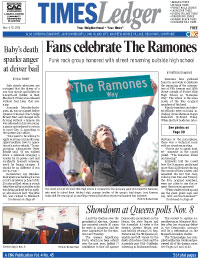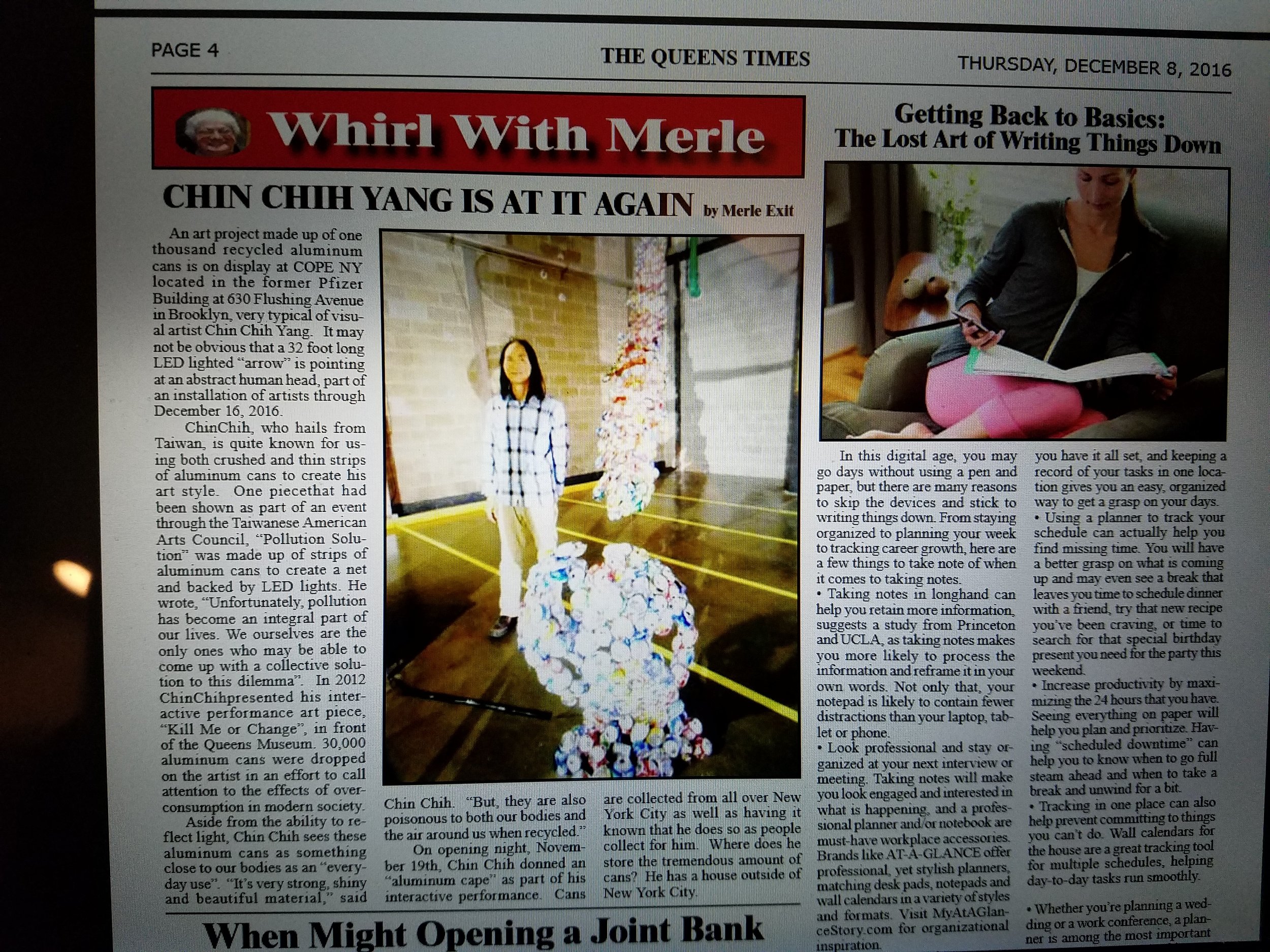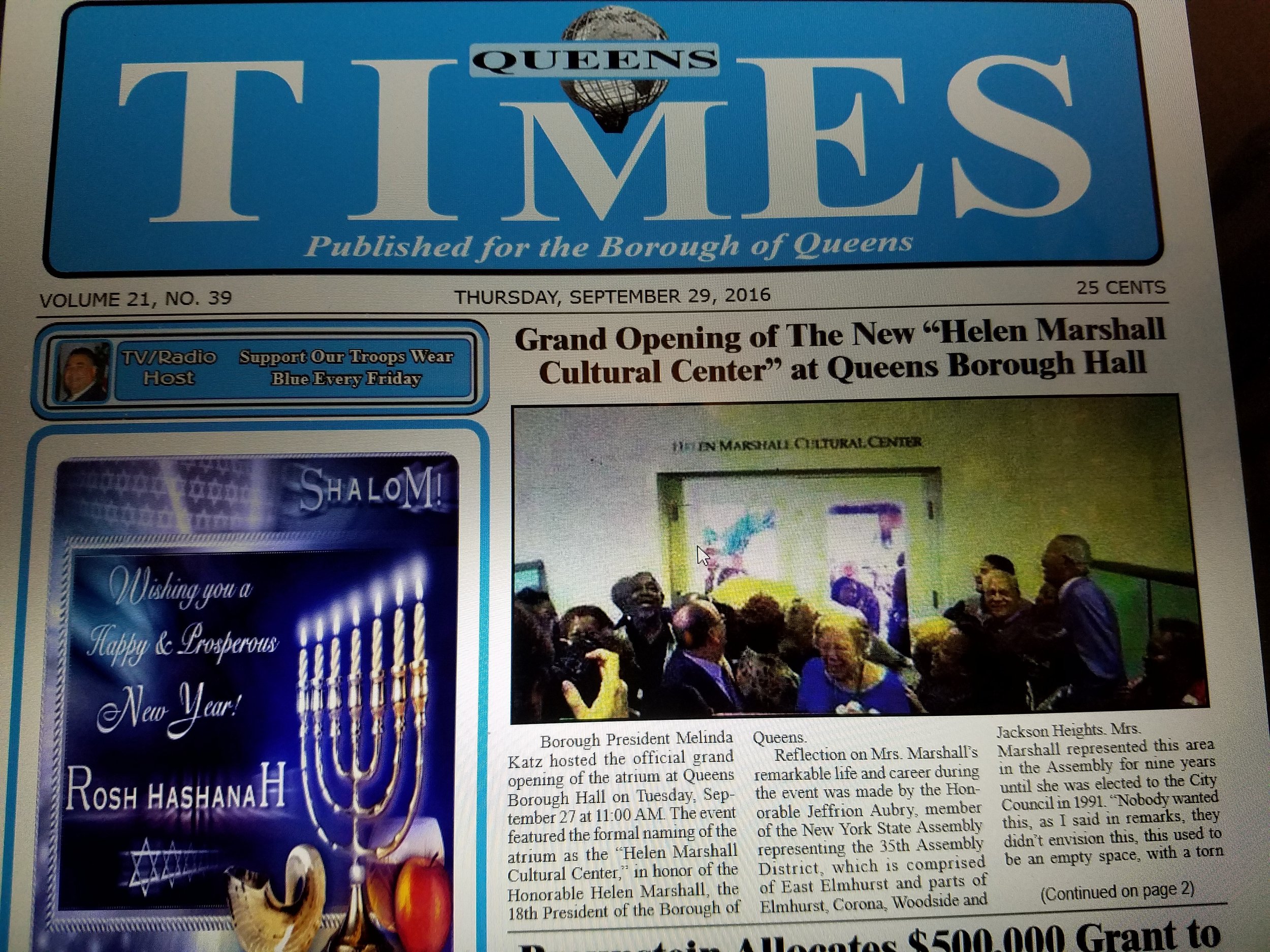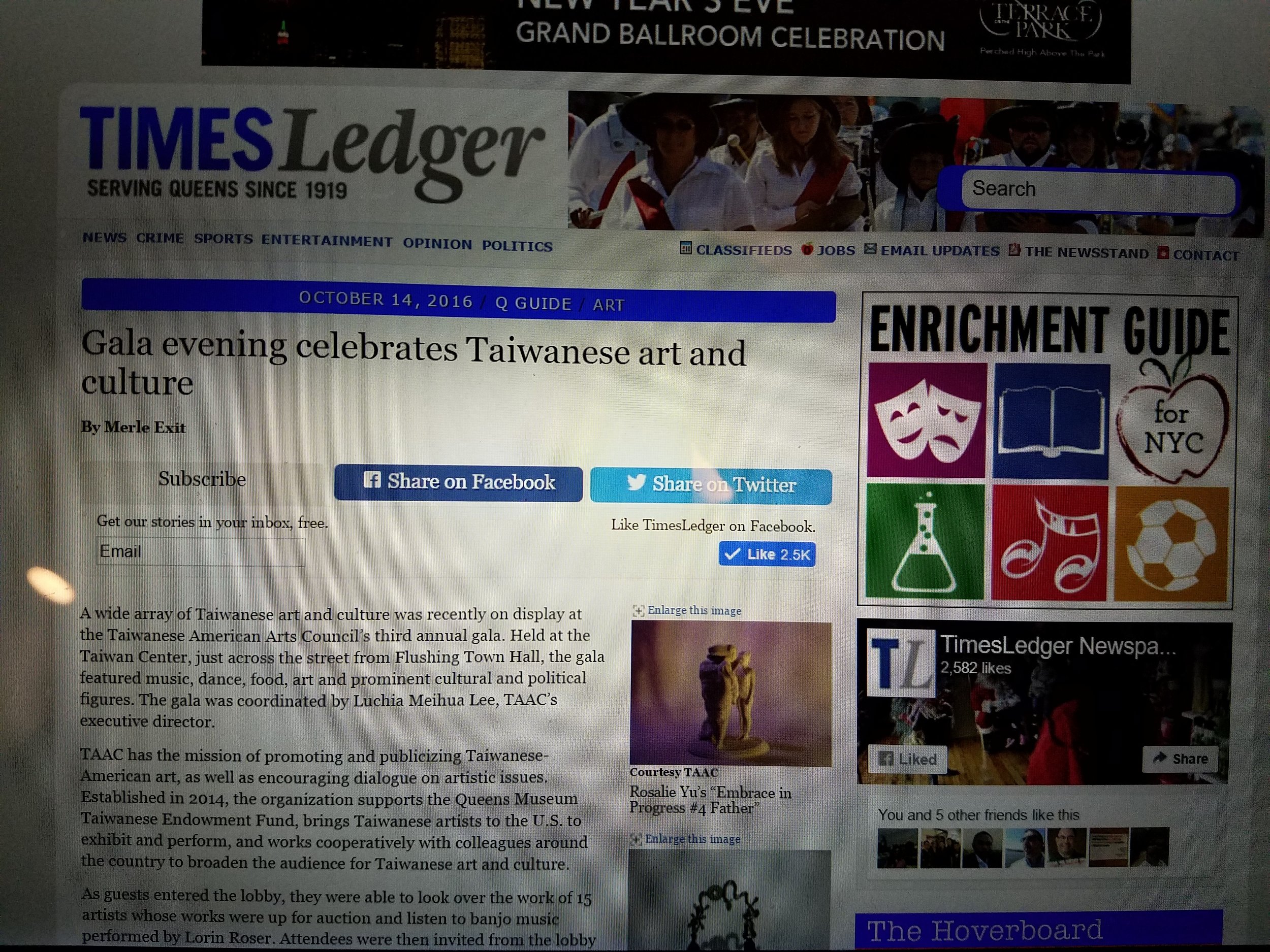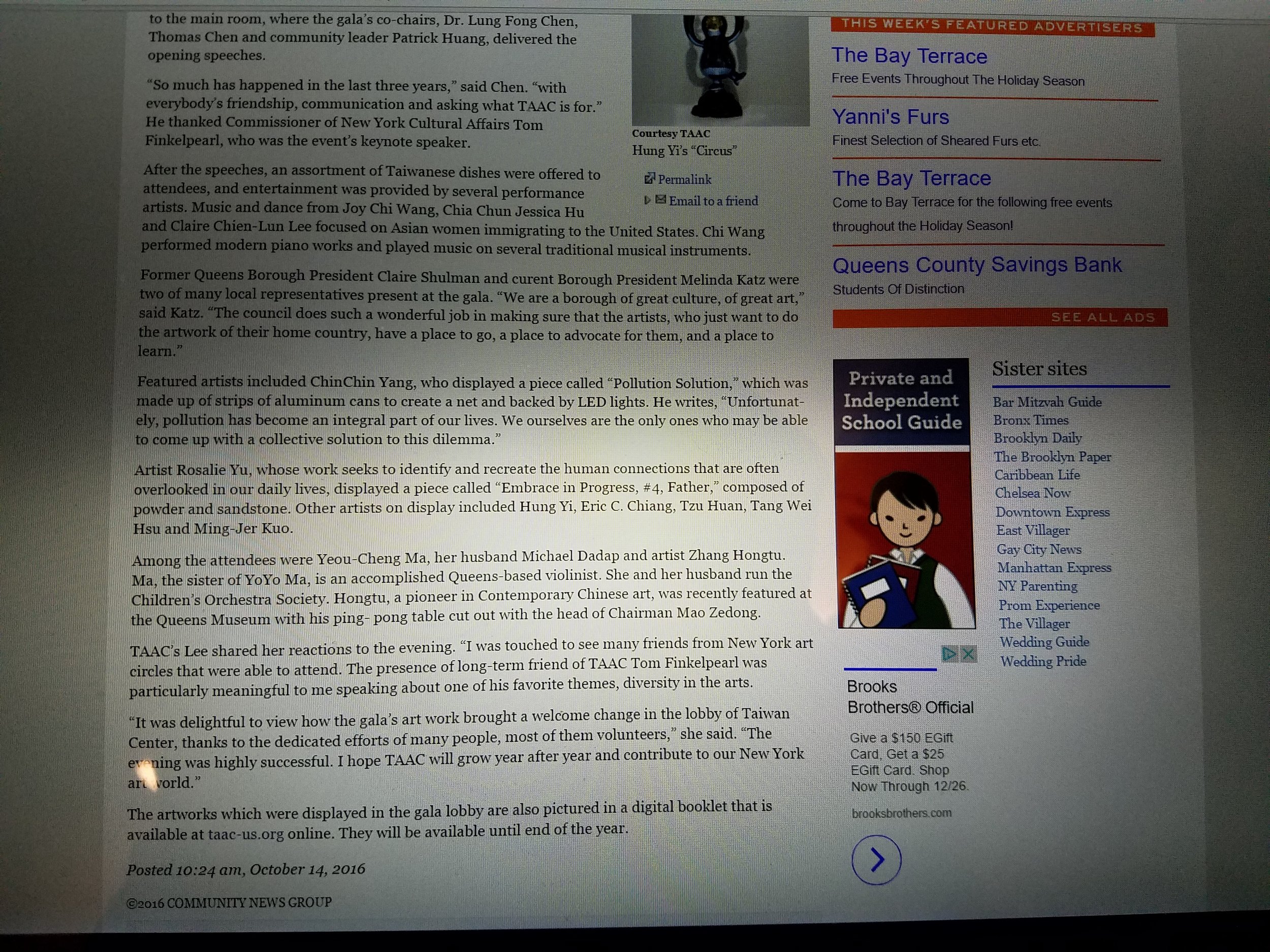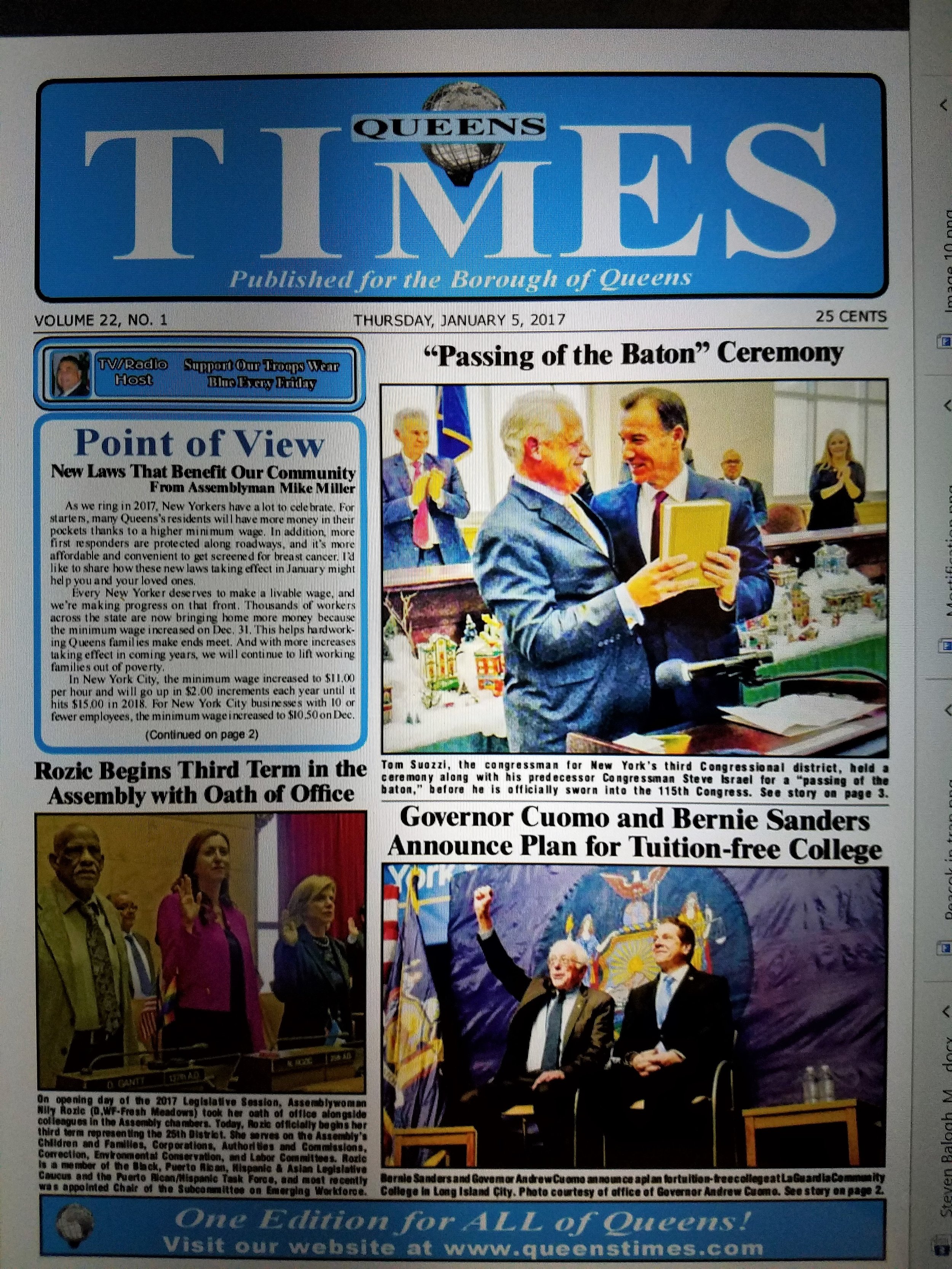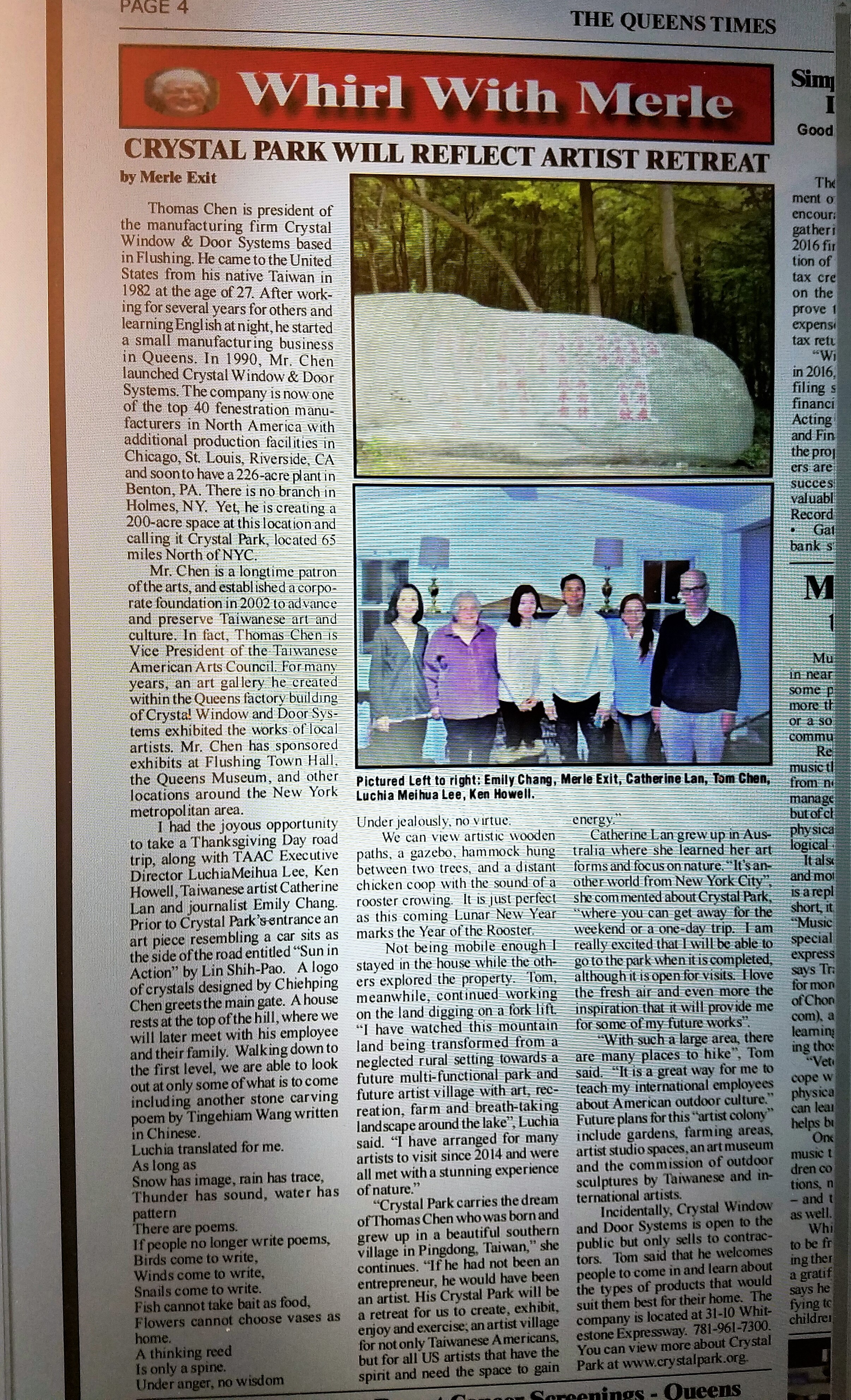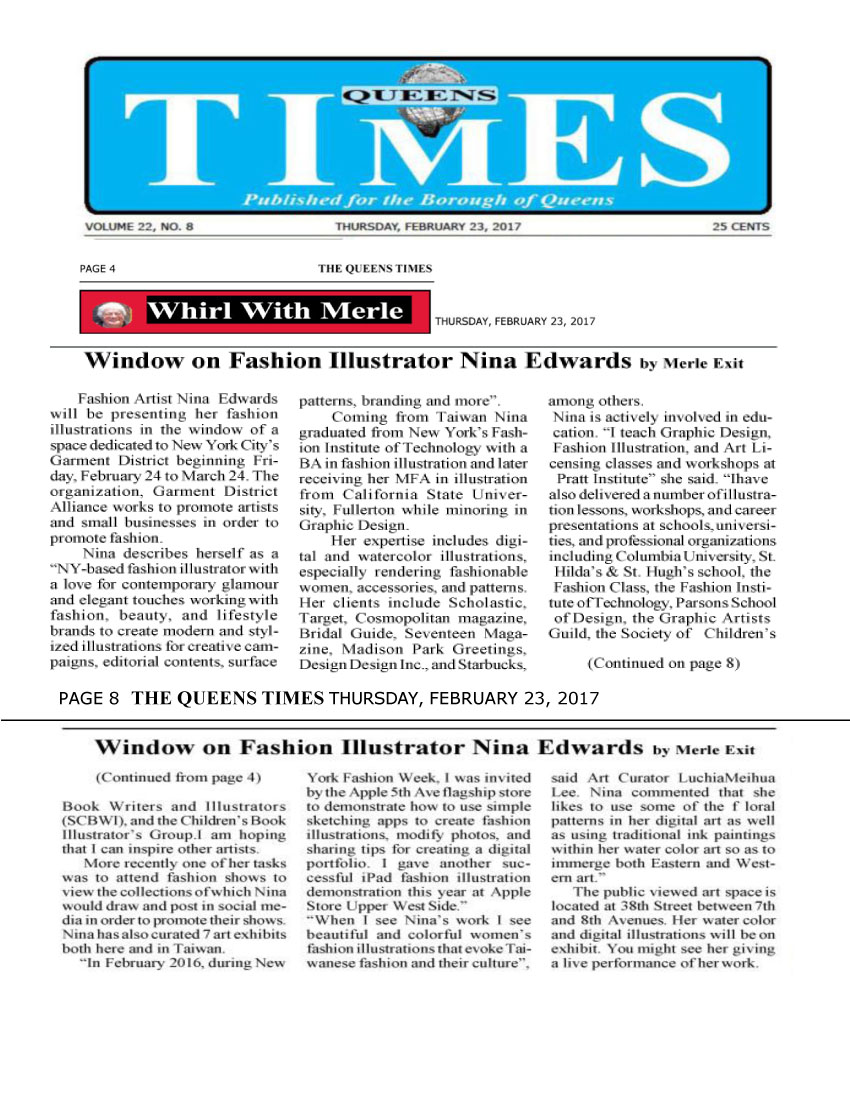An emotional wellness of art
NYC Art Bridge
An emotional wellness of art
Luchia Meihua Lee
"The value of a work of art … lies in its power to bestow happiness. The values of this power naturally stand in a causal relation to the psychic needs they satisfy.”
--Wilhelm Worringer (1881-1965), “Abstraction and Empathy, A Contribution to the Psychology of Style
Art historian W. Worringer argued that artistic creation should strive for the truth of organic life, characterized as a form of naturalism that reflects empathy. From this perspective, art establishes a connection with the external world, removing it from arbitrariness and randomness. By doing so, art purifies the flux of being and attains an appropriate absolute value. Moreover, if self-alienation is regarded as a profound driver, then art can be appreciated precisely because it is psychologically motivated. Art arises from and satisfies psychic needs, thus fulfilling an essential role in human experience.
NYC Art Bridge is an exciting and innovative initiative that aims to bring together different sectors of the community to exchange ideas around mental health and art. By creating a network that includes art professionals, mental health professionals, families, and individuals, the initiative provides a safe and culturally-informed space for discussion of experiences and feelings about mental health. The focus on collaboration, beauty, and harmony speaks to the potential for art to serve as a unifying force that brings together people of various backgrounds and experiences.
While the aesthetic sense of antiquity is inadequate to explain all of art history, a more modern and comprehensive view sees art creators as driven by an inner need and seeking self-activation through a process of empathy, allowing mankind to locate itself in relation to the cosmos. Empathetic art can take various forms and reveal itself as a natural vitalization or a psychic impulse. However, while the concept of empathy explains some parts of art well, it fails to value the full artistic panoply. To complement empathy, Worringer famously appealed to abstraction. The selection of artists presented in NYC Art Bridge promotes a discourse on the concepts of empathy and abstraction in an aesthetic system.
Through art creation and discussion, people can travel towards mental wellness as they explore and express their emotions and thoughts. Rather than merely attempting to capture the outer world, they strive to redeem the given object through the transformative power of art.
Having deliberate discussions with these artists can yield deeper insights into the inspiration behind their artworks, and how their personal experiences condition their artistic practices. These interviews can also help foster a sense of community among participants and promote open and honest conversations about mental health and wellness.
It may be argued that the highest beauty and artistic fulfillment can only be achieved when the artist expresses ideas that are in harmony with the appearance of the outer world. This may involve confronting our spiritual dread of time and space, which can be bewildering but can also lead to a deeper understanding of the world.
Medical science has recognized the potential of art in revealing mankind's creativity and promoting mental wellness, which can help individuals enter into a relationship of friendly confidence with the outer world and lead to a shift from the practical, material world towards a more abstract and peaceful expression. By exploring these themes and showcasing the work of diverse artists, the NYC Art Bridge program facilitates a meaningful dialogue about mental health and emotional wellness in our community.
The exhibit highlights the importance of artistic volition and how it has evolved to encompass a wide range of styles and media. It also emphasizes the impact of cultural experience and community on artistic expression and how it can inspire innovation and creativity. Artists use their unique life experiences to create art that can provide a new perspective on the universe and ourselves. For example, Huey-min Chuang's paintings and drawings about her personal journey, Cecile Chong's video about language learning, Poyen Wang's animation showing a lonely boy, Hsin-yi Liu's painting of a busy teddy bear, and CHATogether's graphic novel about parenthood all offer different ways of looking at the world and potentially inspire viewers to reflect on their own lives.
Leo Tolstoy's perspective on art as a means of communication and progress is particularly relevant to the importance of art in bridging the gap between different cultures and communities. In the Asian community, belief often takes precedence over scientific psychiatric treatment, leading to a need for alternative approaches to addressing mental health concerns. Hence, art can provide a means of expression and communication that transcends cultural and linguistic barriers.
Moreover, by emphasizing the imperfections and inconsistencies of life, art encourages a sense of empathy and compassion among individuals, promoting social and emotional healing. This aligns with Tolstoy's notion of art as a means of defining the highest good at which society aims, and agrees with Worringer’s recognition that every style of art represents the “maximum bestowal of happiness for the humanity that created it,” and his feeling that this should be the supreme dogma of all objective consideration of the history of art.
Exploring the dimension of artistic volition and bringing together artists, mental health professionals, and the public in a cross-disciplinary setting, NYC Art Bridge can help promote emotional wellness and facilitate frank discussion about important issues facing our community. By addressing themes such as bias against the AAPI community and the immigrant experience, the project can help raise awareness about pressing social and cultural issues while also providing a platform for artists to express themselves and showcase their work.
Now, art can serve as a means to explore deeper aspects of human existence and the world around us, including spiritual and philosophical dimensions. Hence, through artistic expression, artists can convey complex emotions and ideas that might be difficult to put into words, and thereby enrich our understanding of ourselves and the world we inhabit. Ultimately, the goal of NYC Art Bridge is to provoke discussion of the urgent social issues of the moment.
References:
Worringer W. Abstraction and Empathy: A Contribution to the Psychology of Style, International Universities Press, New York, 2014
Tolstoy, L. What is Art? Digireads.com Publishing, 2020
Mukařovský, J., Abstract Functions, in Harrison C and Wood P, Art Theory 1900 - 2000, Blackwell Publishing 2006
Schapiro, M., The Social Bases of Art, in Harrison C and Wood P, Art Theory 1900 - 2000, Blackwell Publishing 2006
From Sunflower 2014 of the 10th Year before and after
From Sunflower 2014 of the 10th Year before and after
By Luchia Meihua lee
Taking a stand on contentious issues may result in a particular group of peoples who act as a whole by refusing to compromise their statements or actions. In this peoples’ movement exhibition, we have examples of this. These movements, as James Davison Hunter highlights, may project solidarity and support. If we explore the arena of social strife - which goes by the name “Culture Wars” in the US - Hunter has observed ”the whole point of civil society …is to provide mediating institutions to stand between the individual and the state, or the individual and the economy.” Movements like these, when successful, leave a feeling of empowerment and the ability to make a difference, and may thus provide the desired mediation. On the other hand, cultural and art institutions can offer their communities a place to decompress, take a break, and hence might play a role in inclusive framing of values. [2] Peoples’ movements explore the cultural, political, and economic challenges facing society and devise strategies to shape a better tomorrow. They might change the boundary to serve society, and can provide a window and spotlight on the current challenge of efficiency to the world of volatility.
In March 2014, young people led Taiwan’s Sunflower Movement which in time completely reversed the course of Taiwan’s foreign and domestic policy. On the 10th anniversary of the movement, we would point out that social and political change is won through the brave spirit and effort of the movement leaders and the people - not awarded as a lucky accident. This program will involve artists celebrating peoples’ political movements – largely youth-led – that took place around the world circa 2014. We select 5 movements: the Sunflower Movement, the Arab Spring, the Chilean Winter, the Ukrainian Euromaidan movement, and Hong Kong’s umbrella movement – all of approximately the same era as Taiwan’s Sunflower movement – to which artists will respond.
First among them, of course, is Taiwan’s Sunflower Movement in which students and other youth occupied Taiwan’s legislative body in protest of the plan by the ruling government (that of Ma Ying-Jeou) to strengthen trade ties with China. The Sunflower Movement was successful in blocking the proposed legislation, and led to many of its participants eventually entering formal political life and thus rejuvenating Taiwan’s political culture. Its tenth anniversary will be on March 18, 2024.
Artists were not absent from the Sunflower struggle, or the others. Many were in the first line of chargers, and they were also present to leave records. They may have used a paintbrush, a camera, or a video recorder. All reports - in any medium - have become documents, and some have also been selected to be displayed in this commemorative exhibition.
Other movements to be celebrated will be Hong Kong’s Umbrella Movement, which took place between 26 September and 15 December 2014 – so 2024 will also mark the 10th anniversary of this movement. Led by Hong Kong youth, this movement was sparked by China’s proposed changes to Hong Kong’s electoral system – changes that the movement unsuccessfully opposed and were later imposed unilaterally by the government in Beijing. However, this movement was resurrected on its fifth anniversary in 2019 to protest the bill enabling extradition to China – and trial there – of residents of Hong Kong. Beijing eventually imposed this bill on Hong Kong, further eroding the special status of Hong Kong in violation of the 50-year special administrative status of Hong Kong negotiated by the United Kingdom and China in 1997. However, this exhibition glorifies the spirit of public self-sacrifice exemplified in Taiwan’s Sunflower Movement, and in evidence in each of these popular movements. In addition to participating in actions, behavioral simulation performances and complete documentation of documents, artist K.C. Wang also established a database of the movement on social media.
The Arab Spring is represented in this exhibition by the movement of refugees that it occasioned, like many other revolutions and all social upheavals. While the Arab Spring took place in several Arab countries, with varying degrees of success, in the early 2010’s, the it started in Tunisia, and then spread to Egypt, Libya, Yemen, Syria, and Bahrain. In Egypt, Libya, Yemen, and Tunisia, rulers were deposed. Protests took place across the Arab world, most particularly in Morocco, Iraq, Algeria, Lebanon, Jordan, Kuwait, Oman and Sudan. All these were movements by youth in opposition to authoritarianism and in pursuit of democracy as well as a brighter economic future, and so fit the theme of this exhibition. While 2024 will be the 12th or 13th anniversary of this movement (depending on which country one looks at), it deserves to be included in this exhibition because of its aims.
The artist chosen this time, Mourad, is a Syrian member of Armenian descent. The "Four Acts for Syria" video animation work is a sad historical lyric poem. The panorama opens with written Arabic characters on the screen to open the preface and story. A work directly recalling desperate emigration was chosen, a ship entitled Sailing to Nowhere, carrying the faces of the victims and the dead.
Numerous political movements in South and Central America were youth-led protests. Perhaps one of the most notable was that in Chile in 2011 to 2013. Known as the Chilean Winter, it was a student-led protest against the poor for-profit educational system – especially the post-secondary educational system - extant in Chile at that time which tended to perpetuate Chilean class structure because the children of the very rich had adequate educational choices, but not the children of middle-class families. This system dated to the dictatorship of General Augusto Pinochet, who was not more benign than General Chiang Kai-Shek in Taiwan.The Chilean female artist, María Verónica San Martín, listed the names of some of the people who were massacred by the dictator in her artist's book. In both Taiwan and Chile, the transition to democracy took place peacefully – without a revolution – while political movements such as those discussed herewith fine-tuned that democracy.
The youth movements in Ukraine were known as the Euromaidan Revolution or Revolution of Dignity. The movement is named after Maidan Nezalezhnosti (Independence Square) in Kiev, one of the first sites of demonstration on 18 February 2014; the protestors at one point also attempted to occupy the legislative branch. Unlike with the Sunflower Movement in Taiwan, armed police stymied this move, killing, wounding or arresting numerous protesters. The achieved aim of the Euromaidan movement was to topple President Yanukovych whom the protestors considered too close to Russia. Yanukovych had negotiated an agreement for Ukraine to join the EU, then declined to do so in favor of closer ties with Russia – an echo of the closer ties with China advocated by Ma Ying-Jeou in Taiwan.
Ultimately, the success of the Euromaidan revolution, which was supported by speakers of Ukrainian and opposed by Ukrainian speakers of Russian, emboldened Russia to seize the Crimean Peninsula, a Russian-speaking area of Ukraine. I have chosen two artists; one is the exiled Ukrainian artist Oleksii Koval who highlights traditional Ukrainian cultural spirit; a highlight that does not seem political until one considers that the right to celebrate Ukrainian culture was won in the Revolution of Dignity. The other is Taiwanese American artist Lin Shih-pao, who has been addressing the Ukrainian-Russian war explicitly through artistic creation and action in recent years. In keeping with his overall concentration on human rights issues.
This exhibition thus celebrates youth-led popular movements of approximately 10 years vintage and simultaneously highlights both the similarities and differences between them. Social and political change is never straightforward and compartmentalized, let alone complete – which is why we have chosen a variety of such movements.
Artists in Peoples’ Movements
Tsung-Jung Liu was a Sunflower Movement frontline artist in the sense that he participated in the movement. Liu uses art to comment on social issues such as Taiwan’s Dapu controversy. In June 2010, Miaoli County Magistrate Liu Zhenghong deployed construction cranes in the rice fields of Dapu, thus destroying the rice that was about to be harvested and shocking the country. The issue of land expropriation spread. The forced demolition incident in Da po moved 20,000 people to take to the streets in Taipei to protest, and they occupied the Ministry of the Interior for an all-night sit-in, demanding an apology and compensation, return of the land to its original owners, thorough investigation of the abuses, and immediate amendment of the law. Many members of the Sunflower Movement were also involved in protesting this policy of land appropriation.
From 2012 to 2014, large mural portraits were completed, symbolizing the determination of Da Pu residents to protect their homes. In July 2014, artist Liu Tsung-Jung startedhis wall painting at the original site of demolition Cheung Pharmacy to create the "Four Evil Men" paintings. The paintings included portraits of Ma Ying-jeou, Wu Dunyi, Jiang Yihua, Liu Zhenghong who caused the Da Pu Incident. In following such events, he participated and walked the frontline to show a strong will to advance social justice. In his studio, numerous archives are collected to document the historical records. His large painting Illuminating Darkness is a spirit symbol of the Sunflower Movement. He skillfully painted other portraits such as Lee Deng Hui, embedded in Jade Mountain. Also he depicted the pioneer of Taiwan Independent Shi-Min. Passionate in care of his country, his humble personality and love emanates from his deep Christian belief.
Enbion Micah Aan is a New York human rights activist photographer,currently living and working in Taipei. He cares about all people’s movements, as may be seen from his photographs of demonstrators for numerous causes. For example, he documents support in New York for the Sunflower Movement, protests demanding textbook reform - which mirror those needed in Taiwan - and the conflicting passions initiated by Hong Kong’s Umbrella Movement. His picture of indigenous people protesting the Dakota Access Pipeline recalls the plight of indigenous people world-wide.
Island Sunrise is a group of participants in the Sunflower Movement. Although the portrait artist would like to be identified simply as a member of Island Sunrise, he has painted over 12 paintings during the occupation of the legislative Yuan. These portraits might be of any people participating in the protest, and their names are unknown - in keeping with the democratic spirit of the movement. The group also made a documentary video to record the demonstration.
Hsin-Yi Liu, participated in the Sunflower Movement protests. In keeping with her artistic practice, she used soft middle tones to paint two large abstract paintings revealing the chaos of Taiwan, China and the world situation.
Chia-Hsuan Kuo is a social activist sculptor who made a bust of Dr. Lai Ching Te, who was elected President of Taiwan in 2024 in a continuation of the evolution of Taiwan's democracy. This is in the spirit of Liu Tsung-Jung’s portraits of former President Lee Teng-hui, the father of Taiwan’s democracy, who ended the rule of the Chiang Dynasty. It also connects with Liu’s portrait of Shi Ming, the godfather of Taiwan independence.The appearance of these people together represents Taiwan’s democratic transformation to a large extent, and supports the values of the Sunflower Movement.
Oleksii Koval is an Ukrainian artist in exile. His chosen method is hot enamel, and he makes large lithographs, and paintings. His work is detailed and ornamented, and presents a type of royal and metallic surface atmosphere which persists even in a two dimensional print or silk fabric. In this exhibition, he shows a large striped fabric print similar to what a queen or king might wear, and includes imperial motifs on the fabric. While also in some way this piece is relevant to the current Ukraine-Russia war, it shows the classical splendor the past is gone with the wind, and at the same time celebrates traditional Ukrainian culture in the face of tumultuous political events. Two palms placed together pray for a future unknown and unpredictable.
Taiwanese American artist Shih-Pao Lin is an artist with themes of humanitarianism in the Ukraine-Russia war. He was walking to the war zone in person. In 2023, he started a drawing series entitled “One painting, one prayer”, in which he first painted the blue and yellow background on the paper, then started his small paintings which were only 8 by 10 inches in size, and he did fundraising for Ukrainian artists.
In the exhibit, we can see a 5,000-kilometer map showing the road that Shih Pao Lin traveled in Ukraine with Ukrainian NGOs members in two weeks. They passed by various towns and got close to the front line. Along the way, there were many cemeteries with winged statues of soldiers who sacrificed their lives for the country. Each time a cemetery was visible, we all got out of the car to pay tribute to the soldiers. Lin said, there are so many cemeteries that I cannot remember that there were so many people in that town
Turning to the catastrophic Chilean Winter, the revolution in Chile was ironically non-violent and successful in that the country is no longer under the dictatorship of Agusto Pinochet. The violence practiced by the regime came during Pinochet’s reign and afterwards. Female artist María Verónica San Martín, a Chilean human rights print artist and scholar, has very bravely chosen to use her art work to maintain the memory of and to memorialize the people who sacrificed and were sacrificed by the government. She uses woodcut prints and silk prints in making fantastic art. She also uses mixed media to reveal her beautiful country in a sublime beauty landscape, while addressing the suffering of the people
Arab Spring, for the countries in the middle east, I might include artists from Yemen, Egypt, Jordan or Tunisia - or many other countries which experience unrest. I choose Kevork Mourad, a Syrian-Armenian artist whose family was exiled due to the Armenian genocide perpetrated by the Turks. In all periods of human history genocide has occurred but most prominently in the 20th century. The Turkish killing of Amenians might almost be almost forgotten - for example, Hitler famously said “Who, after all, speaks today of the annihilation of the Armenians?” Mourad’s “Four Acts” video piece that follows his black-and-white fabric cutting and illustration style, is a sad historical lyric. Over a background of haunting, exotic music, the video shows in Arabic characters, over an English translation, a poem describing the desolation of a migrating people. The viewer enters an unpopulated, empty, abandoned splendor. Pathetic bundles reveal death, ruin, slaughter, and exposure. To complement the bleakness of this video, I have selected a work showing a sailing ship, titled Sailing to Nowhere, carrying the faces of the victims and the dead.
Many artists are unlike Hong Kong’s Umbrella Movement artist Kacey Wong, a Hong Kong social activist artist. He has mentally and physically suffered in Hong Kong’s movements. Although now he is living peaceably in Taiwan, yet the shadows still make him tremble and cause him nightmares. Not only did he walk Hong Kong's streets during the protest, participating in the Movement, he acted, performed, and documented it. His studio shows all the performance masks, toy humans, and Molotov cocktails transformed into visually beautiful sculpture. His under-the-yellow-umbrella drawings, sketches of anonymous protesters underlines the solidarity generated by the movement.
A people’s movement often provides a spotlight on timely perils and exposures, and thus helps give potential clues about how the government can modify its behavior to better serve the community. The movements, as a whole in common ground, in Hunter’s words “are mediating, educating." by launching these movements as an echo of society’s concerns. People’s movements engage in hard conversations, in their society, country and with communities. People are continuing to fill a critical role in each century.
References:
https://www.civilmedia.tw/archives/20038
大埔強拆周年》歷史不能忘記 大埔事件公庫全紀錄 | 公民行動影音紀錄資料庫 (civilmedia.tw)
Culture Wars: The Struggle to Control The Family, Art, Education, Law, And Politics In America Paperback – October 14, 1992
Culture War 2.0, Museum, January/February 2024. American Alliance of Museums. P. 12
The Activist Legacy of Taiwan’s Sunflower Movement, Ming-sho Ho, AUGUST 02, 2018. ARTICLE Source: Getty
Bi-khim Hsiao, A letter to the public 蕭美琴 Bi-khim Hsiao , March 25, 2014 ·
https://www.facebook.com/100044353752888/posts/10152034392490687/
From Taiwan to New York: An Unbroken Continuity of Art Connecting Islands
From Taiwan to New York: An Unbroken Continuity of Art Connecting Islands
at TAAC House 7b, Nolan Park, Governors Island
From Island to Island
For two consecutive years, the Taiwanese American Arts Council (TAAC) has been selected as a residency and performance unit on Governors Island in New York. As the only Asian organization to receive this honor, TAAC is the most important nonprofit organization in the Eastern U.S., and possibly the entire country, promoting Taiwanese-American artistic exchanges. In just these two years, TAAC has gathered over 100 Taiwanese and international artists and performers, capturing the attention of global visitors through marathon-style exhibitions and performances.
Governors Island is a historic gem at the southern tip of Manhattan. This beautiful small island was originally a colony occupied by the Dutch West India Company in 1624. By 1785, it was transformed into a US Army base and barracks, and later served as a station for the U.S. Coast Guard. During turbulent times of war, the island played a crucial role in defending New York Harbor. In 2003, it was officially taken over by the New York State government, which established several operational units, preserved and restored the island’s historic buildings, and developed it into a unique tourist destination with a focus on recreation and the arts. Now, just a five-minute ferry ride from Manhattan, it is a tranquil cultural haven. To imagine it from a Taiwanese perspective, it’s like a small island cultural park just a five-minute ferry ride from Taipei Main Station. After 20 years of careful management, Governors Island attracted 710,000 visitors in 2023, becoming a sought-after cultural destination for both New Yorkers and international tourists.
In 2023, Governors Island launched an artist residency and exhibition program that excited New York's art scene: the Governors Island Arts’ annual Organizations in Residence program. The management provided 25 houses for New York art and nonprofit organizations to apply for residencies from May to October, rent-free, for six months of creation and exhibition. For space-constrained Manhattan, this is an incredible opportunity. Amid intense competition, the Taiwanese American Arts Council stood out with its theme, "From Island to Island," securing residency at House 7B in Nolan Park. In 2024, the organization was once again selected, this time with the theme "Island Sunrise," marking a new milestone for Taiwanese nonprofits in the U.S.
During these two years of marathon-style exhibitions and performances, TAAC invited over 100 local New York artists, artists from Taiwan, and others from around the world. The scale is almost akin to a new form of international biennale. Due to the large creative team, TAAC hosts new themed exhibitions monthly, showcasing a rich diversity of cross-island international artistic perspectives. Not only does this promote the talents of individual artists, but it also enhances the understanding and appreciation of Taiwanese art and culture among American and international audiences, significantly boosting Taiwan's global image.
New York-Taipei: Eve Clone in Two Cities
In 2023, the first year TAAC participated in the Governors Island residency program, most of the featured artists were New York locals. However, due to the six-month-long series of performances and the related media coverage, it quickly caught the attention of the art community in Taiwan. TAAC, hoping to invite more Taiwanese artists to showcase their work in New York, the world’s art capital, has significantly increased the number of Taiwanese creators in this year’s artist lineup. Among them is Lin Pey-Chwen, the first Asian artist to win the prestigious "New Media Art" global grand prize at the 2019 Florence Biennale. Known as a pioneer of digital art in Taiwan, Lin has been creating art for over 40 years. In July, she was invited by TAAC’s Executive Director, Luchia Meihua Lee, to showcase her latest AI-integrated work, Eve Clone: Wannsee Conference I, at Governors Island.
The title of the piece draws inspiration from Hitler’s infamous 1942 Wannsee Conference, where the details of the plan to exterminate the Jewish people was devised. In her creation, Lin Pey-Chwen uses advanced AI machine learning algorithms and 3D modeling software to enhance the human facial features of Eve Clone. She merges the faces of political and technological leaders, including Putin, Kim Jong-un, Xi Jinping, Zuckerberg, and Obama. Through a voice recognition system, the speeches of these figures are converted into corresponding facial expressions. In addition, Lin exhibits the augmented reality (AR) piece Making of Eve Clone I, where viewers can interact with the work using a tablet. This Taiwanese masterpiece stunned international audiences at Governors Island this summer.
Starting in the summer of 2024, three generations of Taiwanese artists working in new media and technology art have been arranged to exhibit at Governors Island's "TAAC House 7b." These include the Between Mountains and Seas outdoor LED installation by Hu Chin-Hsiang and the Kurokawa Interactive Multimedia Team, under Lin Pey-Chwen's guidance. The young artist Chuang Ching-Yi, mentored by Lin's students, and artist Yang Chun-Kai. who has a background in architecture, collaborated to create a dynamic projection of Taiwan's industrial map, depicting Taiwan as a leading global technology island. The other exhibited works link the history, culture, and geography of both Governors Island and Taiwan, while reflecting current global cultural trends. The meticulously curated interdisciplinary art display by TAAC has become one of the most distinguished and notable among the 29 residency organizations on the island.
The Eve Clone exhibition on Governors Island will run until November 3. Meanwhile, Lin Pey-Chwen has also been invited by a Taiwanese organization to present her Eve Clone: Babel Tower I series at the Her Artistic Imagination: New Media Cross-disciplinary Creation Exhibition, curated by Wang Yu-Ling. This exhibition is being held at the third exhibition hall of the Chiang Kai-Shek Memorial Hall and runs until November 2, creating an unexpected cross-city journey for Eve Clone between New York and Taipei. In Her Artistic Imagination, Lin Pey-Chwen will showcase her work alongside artists from different generations, including Chen Yun-Ju, Chen Yi-Chun, Hsu Yi-Bai, Wang Zi-Hsin, and Hung Yi. This exhibition invites the public to experience the charm of virtual and real interactive, cross-disciplinary creations, offering a firsthand look at how technology permeates daily life and culture. These exceptional Taiwanese female artists have used digital technology to break through traditional gender boundaries in art, demonstrating the incredible power and emotional impact of their work.
A Decade of Success for TAAC
The Taiwanese American Arts Council (TAAC), the most influential international platform for Taiwanese artists in New York, is celebrating its 10th anniversary this year. It was founded on July 19, 2014, in the grand hall of the Queens Museum in New York, where over 300 guests from across the U.S. political, business, and arts communities gathered to witness and celebrate its launch. The founding president, Dr. Lung Fong Chen, one of the co-founders of the Taiwan Center in New York, was joined by three founding board members: Huang Tsai-Tien, founder of Brooklyn Arts Studio (BAS); Chen Chiu-Kwei, Chairman of Concord Windows; and senior curator Luchia Meihua Lee. Additionally, Liao Shiou-Ping, a pioneering artist of modern Taiwanese printmaking, served as Honorary President. Luchia Meihua Lee took on the role of Executive Director, and over the past decade, TAAC has persevered through challenges to organize numerous exhibitions and exchange programs for both Taiwanese and international artists. It has also built a vast network of connections with art venues and cultural organizations in the Greater New York area, promoting the cultural and artistic exchange between Taiwan and the global stage in this major international art hub.
Later, Ming Chiang, Executive Director of "Hello Taiwan," and Patsy Chen, Artistic Director of the New York Youth Orchestra CYCNY, joined the board, contributing to the association's operational vision. Dr. Ken Howell, the husband of Executive Director Luchia Meihua Lee, has selflessly served as a spokesperson and liaison for American institutions. This year, James Yang, Chairman of First Commercial Bank in Flushing, has taken on the role of TAAC’s new president, while Fulbright Scholar Liliane Huang serves as Co-Curator. Together, they continue to build an invisible yet invaluable bridge of artistic and cultural exchange between Taiwan and the U.S., fostering a powerful voice for art and culture during times of political unrest, using art as the most beautiful and impactful form of expression.
最熟悉的陌生人:來自林珮淳的《夏娃克隆萬湖會議 I》
最熟悉的陌生人:來自林珮淳的《夏娃克隆萬湖會議 I》
作者:李美華
被從顯示28個陌生人面孔的視頻螢幕中傳來的嘈雜聲吸引,我們注意到他們全都在同時說話。奇怪的是,他們的面孔似乎很熟悉; 經過仔細觀察,我們意識到這些「陌生人」實際上是來自世界各地的領導人和名人。在逐漸識別這些陌生人的身份後,觀眾通常會微笑或大笑,並對探索藝術背後的理念產生興趣。
在林珮淳的這件藝術作品中,這些名人的面孔與AI生成的「夏娃克隆」(Eve Clone)融合,形成型變和怪異的外貌。在今天這個被媒體充斥的世界中,我們經常在新聞頻道、脫口秀、政治訪談等節目中看到這些公眾人物。他們變得如此嵌入我們的意識中,以至於感覺像我們的鄰居、親戚或朋友,即使我們從未見過他們。如果我們有機會親自遇到這些名人,可能會感到困惑、懷疑,甚至因為無法立即記起他們的名字而感到尷尬,但我們會確信我們應該認識他們; 這種掙扎會讓人感到不安; 當我們突然記起他們的身份時,會因為認識到那個在電視上頻繁出現的人實際上不是朋友而感到震驚。這種現象揭示了公眾人物對我們日常生活的深遠且常被忽視的影響。
《夏娃克隆萬湖會議 I》(Eve Clone Wannsee Conference I)上的28張面孔,以真實著名人物為模型,通過AI技術實現沉浸式呈現,強有力地展示了這些熟悉的陌生人如何佔據我們的思維。
人類與AI:從概念到現實的参訪者體驗
讓我們回到伊曼紐爾·康德(Emmanual Kant) 所認為的核心問題: 「什麼是人類? 」[i] 這一普遍問題始終保持其相關性。部分答案是,人類意味著擁抱文化多樣性,同時重視個體。而且,即使面對出生的偶然,人類仍需堅持理想。另一個方面涉及對自然和社會系統的敬畏,這一點通過藝術話語來探索。正如蘇格拉底(Socrates)所指出的六大核心價值——美德,慈善、正義、勇氣,中庸,和虔誠[ii]——我們能否在未來追求這些理想?這些問題是否仍然相關,還是我們對人性的理解會在AI或克隆技術的時代被重新塑造?
預測我們的未來,甚至我們的現在,會越來越屬於高科技,如AI、VR和AR,已經成為時尚。在這種願景中,民族性和其他人文關懷似乎將融入一個烏托邦的未來。然而,斯蒂芬·弗萊(Stephen Fry)認為,我們生活在一個洪泛平原上,一場大風暴即將來臨[iii]。最迫切的,也許是逆向直觀的,為了準備一個充滿技術的未來,我們必須加倍努力理解什麼是人類,機器能做什麼和不能做什麼,以及它們可以支持我們哪些優先事項。藝術和人性比以往任何時候都更加重要, 我們需要理解我們的靈魂、精神、美感、愛、靈感、忠誠和同理心。機器的廣泛使用將給我們更多的時間,因此理解如何以及為什麼我們可以實現我們的真正命運變得至關重要。
無言的對話
這個概念讓我們想到AI生成的世界領導人和名人的形象——如《夏娃克隆萬湖會議 I》中的形象——代表了那些被合併成名為「夏娃克隆」的創造物。正如先進技術和創造性科學能從電腦實驗室中生成「夏娃克隆」,一個單一的DNA啟用細胞也能發展成真正的生物人類,且不論這個人類的精神思想等事;雖然我們知道「夏娃克隆」的概念可能即將出現,她可能不會以機器人的形式呈現在我們身旁, 却可能以控制了生活模式或是在非可見的時空中操作。相反,人之為具有卓越本質的「萬物之靈」,道德考量將決定我們允許這一進展的程度;真正的問題在於如何導航這些可能性:一個社區如何既假裝又保護,並且需要哪些策略來防止這些情境變成現實,如藝術家林珮淳所引用的聖經章節?
在我們當前的世界中,跨政治地理和各地區的複雜性浮現。遺憾的是,以保護本國人民的名義,國家領導人經常做出聲明,導致衝突,結果是殺害或綁架其他民族群體的成員。這一循環促使戰爭,導致數以萬計的平民死亡。像美國或歐盟這樣的大國在表達對全球和平的關切的同時,卻提供高科技武器以促進暴力。因此,大國展示其軍事力量,並展示其主宰世界的能力。
林珮淳的《夏娃克隆萬湖會議 I》作品,「夏娃克隆」位居正中象徵性畫面上的掌控者,而環繞著的27位政治、軍事、經濟、科技、文化等的權力人物,他們似乎在虛擬世界中被系統集體操縱,以及各說各話。「萬湖會議」(Wannsee Conference in 1942)原是納粹德國官員討論的會議達到少數人掌控落實了系統的猶太人大屠殺;而這場没對話的「夏娃克隆萬湖會議」作品的呈現對現實世界進行了諷刺,在真實世界中也有多個世界領導人的論譠,他們會為參與討論和與其他名人見面並獲得認可而感到自豪,而這些會議也試圖招募來自全球的更多有影響力的領導人参與,這些人物共同控制著世界金融、政治、媒體、經濟和社會。然而,在這次會議中,沒有真正的溝通——只有如巴別塔的無意義喃喃自语。
我們見證了近十餘年來世界各地各種年輕人民運動:如阿拉伯之春、智利的教育人權鬥爭、烏克蘭的獨力革命、台灣的太陽花運動,以及最著名但失敗的香港雨傘及反送中運動,這個旨在保護該國的民主獨立免受中國的侵擾,雖然涉及200萬人的參與卻最終屈服於中國的力量。在這許多的運動中,藝術家使用不同的方式去參與和表達關注;像林珮淳這樣的藝術家巧妙的使用新媒體藝術創作,來揭露這一令人擔憂的趨勢並提高公眾意識。
林珮淳創造出來的「夏娃克隆」角色是批判人類挑戰神甚至自高比做神的各種慾望化身;這些螢幕上的人物說話內容是撒旦向神挑戰與誇口的台詞,是截取自一部電影《神魔交戰》(Megiddo)根據聖經《啟示錄》記載的大規模軍事衝突的世界末日。在世界領導人全體各說各話, 使用每個人自己的語言,啟動了無語言的對話,接著其他人模仿, 到「夏娃克隆」 一個人發言而结束。而在展場循環播放的時段,並無法在很短時間内去分辨是那位在發表,直到回到畫面人群同時講話的混亂噪音吸引了觀者注意,這種鬨鬧的場景就象徵著 缺乏真正的溝通與對話,每個人都似乎在理性表達自己的想法,但却不考慮其他人是否了解。儘管看似這些熟悉的領導人在會議上民主地討論重要問題,但實際上沒有真正的溝通意圖。這是否正是我們當前世界的反映?悲劇的是,這種社會腐敗情景繼續包圍我們,逐漸接管世界並剝奪我們的權利。
《巴別塔上的夏娃》
在另一部新視頻作品中,巴別塔成為背景,一個藍色的、鬼魅式移動動作的「夏娃克隆」在塔頂彎曲著身體站立。根據藝術家的說法,這個「夏娃克隆」正在「跳舞」以展示自己。這個藍色的「夏娃克隆」繼續在世界著名的摩天大樓上搖擺,又如蜘蛛人般的登上了例如紐約的帝國大廈。「巴別塔」的一種解釋是無意義的嘟嚷,它也象徵著最後的巴比倫帝國的崩潰。在這種背景下,《夏娃克隆萬湖會議 I》代表了世界領導人在他們自己的嘟嚷中,沒有任何有意義的溝通。這件作品與《夏娃克隆萬湖會議 I》和其他符號協調,暗示了一個因高科技而走向崩潰的世界,以AI生成的「夏娃克隆」為例。這些AI世界領導人,像他們的人類對應者一樣,似乎將我們拖向全球災難。
雖然創新技術常用於探索外太空,但在這裡,科技被用來創造一個沉浸式的互動藝術展覽。在其他背景下,AR和VR技術通過不同的時間空間連續體讓參觀者探索將可能被隕石撃毁和變化中的宇宙。藝術家林珮淳自2006年開始發展的「夏娃克隆」系列展示了包括VR、AR、AI和運動捕捉攝影等創新方法,將歷史、藝術、神學、數位、教育與觀者參與融為一體。她的作品反映了她致力於吸引和啟發社區的使命,呼應了當代藝術界類似於文藝復興的復興,其中形式、概念和技術無縫地交織在一起。
林珮淳的「夏娃克隆」系列在通過看似傳統的媒介,如繪畫、數學和文學寫作——無論是在紙上還是數位畫布上——這些藝術作品就像歷史上的尋寶遊戲,精心策劃以創造親密的觀展體驗。這些作品深入探討了人類與AI技術之間的關係。也感受到這個創新的想法經由藝術家的扎根及延展。新媒材藝術的創作者充擔了創作與各個領域的與聯结角色,有着藝術創作的思维,還有考慮實施塑造工程的想法,並在管理一步步的流程中實施,並衡量各部细節結果以評估作品的成功呈現。也就是回到文藝復興人(Renaissance man/woman)的角色,他/她在跨領域間穿梭時空,是藝術也是科學,作品同時是古代也是當代的。
林珮淳的「夏娃克隆」在紐約總督島
林珮淳作品2024年再度應邀到紐約個展,參與了進駐在紐約總督島的台美文藝協會(TAAC)「島嶼日出」年度主題系列活動,這座島嶼連結了台北與紐約的藝術文化。策展人特别安排林珮淳「夏娃克隆」系列的完整作品呈現,規劃了2017年自達文西的《夏娃克隆創造計畫I 》錄像,及手部及頭部的AR擴增實境作品;與今年新作《夏娃克隆萬湖會議 I》與《夏娃克隆巴別塔I 》兩件作品一同展出。在這部精心製作的錄像投影《夏娃克隆創造計畫I 》中,我們見證了達文西的「維特魯威人」(Vitruvian Man)到「夏娃克隆」是被如何的逐步被創造轉化出來。今年的AI錄像文件作品《夏娃克隆萬湖會議 I》中,展示了理念與圖像的一致性與延展,以中央女性形象「夏娃克隆」為一種隐藏的聯接,與這27個看起來有詭谲的熟悉與陌生感的面孔排列。這是林珮淳企圖再次把「夏娃克隆」與達文西的「維特魯威人」與這些「權威人物」的瞼部混合的AI與3D 建模技術生成的面孔,作品中的人物頭部出現 如達文西的「維特魯威人」頭部的捲髪,也符合了女性的意象。林珮淳並蒐尋截取這些「權威人物」最代表性的一段語音,使用AI語音同步技術(D-ID),重現了他們的語音和表情。作品揭示了混合的人物語音與野心的面貌,額頭上刻有「666」的符號 也延續了這個的邪惡印記。
林珮淳的「夏娃克隆」系列作品多年來獲得了國內外眾多展覽和超過十項國際影展的肯定,包括第12屆義大利佛羅倫斯雙年展新媒體藝術類全球首獎,以及坎城影展和柏林短片獎等。在今年總督島林珮淳的展覽,傳達了「夏娃克隆」的連貫性的創作概念,從2017的《夏娃克隆創造計畫I 》到2024新作《夏娃克隆萬湖會議 I》與《夏娃克隆巴別塔I 》兩件作品,讓參觀者在參與中感受到其中的意義,展覽於2024年7月份開始展出後獲得許多觀注及回響,也應總督島團体導覽主持的請求延長展期,目前將持續展至11月3日底止。
「夏娃克隆」系列及未來的人性
自2006年以來,藝術家林珮淳一直在發展她的「夏娃克隆」系列,最初探索克隆的概念——從簡單的機器人到現今的AI啟用機器。在技術進步的過程中,我們逐漸進入一個可能需要捍衛道德和美德原則的世界。在這個不斷演變的環境中,區分一個被迷戀的人類般的機械創造物和一具無生命的冰冷身體變得越來越困難。這些實體不僅存在於虛擬世界,她們逐漸成為我們現實的一部分。隨著它們取代人類勞動,我們不禁質疑人類存在的基本價值。
當我們忽視什麼是人類時,即使我們不與額頭上標記有「666」的「夏娃克隆」合併,我們的良知是否能夠覺醒並主張自己?在這關健性的十字路口,與天下禍福與共是具体的迫切性社會議題; 每天都有新技術被開發,那些看似神秘或複雜的技能可能會分散或誤導我們的注意力。作為一名新媒體藝術家,林珮淳總是試圖在她的作品中提出有關人類價值的問題。機器和設備可以不斷改進,發展成為精緻的新技術。然而,更迫切的問題是:這些藝術作品背後的概念是什麼?
在一個技術進步模糊人類與機器界限的時代,「夏娃克隆」系列挑戰我們面對當前的倫理、道德和存在問題。當我們在一個越來越被AI和數位複製品主導的世界中前行時,重新評估我們對人類的理解變得至關重要。這些新技術的興起——無論是克隆生物、AI生成的面孔還是虛擬現實——迫使我們檢視人性的核心價值:良知、同理心和道德。通過提出這些關鍵問題,「夏娃克隆」系列促使觀眾考慮我們選擇對塑造未來的影響,在這個未來中,技術成為進步的工具,而非去人性的催化劑。這樣,該系列不僅僅是藝術;她成為了反思創新與保護我們基本人類價值之間微妙平衡的呼籲。
參考文獻
[i] (Louden n.d.), Louden, Robert. n.d. 《康德的人性:論他的人性理論的隨筆》。牛津:牛津大學出版社。2019年5月4日取用。https://pdfs.semanticscholar.org/f0e6/da6197978d213e17dc76dfa63448decff5b6.pdf
[ii] (Philip C. 2003), 《蘇格拉底的六個問題:世界哲學的現代發現之旅》,麥田出版(城邦出版公司的一個部門)W. W. Norton & Company。April 17, 2005.
[iii] (Fry 2017), Fry, Stephen. 2017. 《相能傑出講座系列 - Stephen Fry,演員,喜劇演員,記者,作家》。10月3日。https://www.youtube.com/watch?v=24F6C1KfbjM
有關作者 李美華(Luchia Meihua Lee)
李美華,(台灣出生,居住與工作在紐約)是一位策展人、文化藝術策劃组織者和寫作者,致力於支持和推廣多元化的藝術家和創作者。她是台美藝術協會(Taiwanese American Arts Council, TAAC)的創會執行長。自1995年起定居紐約市以來,她成功策劃了許多展覽和活動,並在北美和其他地區組織了多樣的講座系列。在紐約從事藝術工作期間,她策劃了多個重要的展覽,涵蓋博物館、藝術機構及畫廊,並積極參與大紐約地區的當代藝術場域,同時出版了展覽圖錄及其他相關著作。她策劃的展覽曾獲得《紐約時報》、《華爾街日報》及其他國際媒體的關注報導。李美華於愛爾蘭都柏林聖三一學院(Trinity College Dublin)取得藝術與建築史碩士學位(M. Phil),其研究以孤島藝術手稿為主題,並著重於中世紀手稿展示的新技術應用。她同時也是多個藝術組織的委員會成員和藝術顧問,並多次擔任皇后區藝術委員會、曼哈頓文化委員會(LMCC)及其他社區藝術組織的評審。自2014年台美藝術協會成立以來,李美華一直擔任該機構的執行長,並持續為這個非營利組織的發展貢獻力量。該組織通過藝術和文化,在國內外建立跨社區的橋樑,以深化我們對美、靈感和同理心的理解。
The Most Familiar Strangers:From Pey-Chwen Lin’s Eve Clone Wannsee Conference I
The Most Familiar Strangers:
From Pey-Chwen Lin’s Eve Clone Wannsee Conference I
by Luchia Meihua Lee
Drawn in by the loud noise emanating from a video screen displaying the faces of 28 strangers, we notice that they are all speaking at once. In a strange way, their faces seem familiar. Upon closer inspection, we realize that these "strangers" are, in fact, leaders and celebrities from around the world. Upon gradually figuring out who these strangers are, viewers typically smile or laugh out loud, sparking an interest in exploring the ideas behind the artwork.
In this artwork by Pey-Chwen Lin, the faces of these celebrities merge with the AI-generated face of Eve Clone, resulting in distorted and grotesque appearances. In today's media-saturated world, we frequently see these public figures on news channels, talk shows, political interviews, and more. They become so embedded in our consciousness that they feel as familiar as our neighbors, relatives, or friends—even though we've never met them.
If we were to meet one of these celebrities in person, we might feel confused, doubtful, or even embarrassed for not immediately recalling his or her name, yet we'd be convinced that we should know it. This struggle can be unsettling. When we suddenly remember who he or she is, we're startled by the realization that the person we see so often on TV isn't actually a friend. This phenomenon reveals the deep and often unnoticed impact of public figures on our daily lives.
The 28 faces of the Eve Clone Wannsee Conference I, modeled after real renowned individuals and made immersive through AI, are a powerful representation of how these familiar strangers occupy our minds.
Human vs. AI: Visitor Experience from Concept to Reality
Let us turn to the question that Immanuel Kant deemed central: "What is the human being?" [i] This universal question has never lost its relevance. Part of the answer is that being human means embracing cultural diversity while valuing people as individuals. It also means holding on to aspirations despite the accidents of birth. Another aspect involves a reverence for natural and social systems, as explored through artistic discourse. Socrates identified five core values—virtue, moderation, justice, courage, good, and piety [ii]—will we be able to pursue these ideals in the future? Are these questions still pertinent, or will our understanding of humanity be reshaped in an era where AI or clones may follow different standards?
It has become fashionable to predict that our future—and increasingly, our present—belongs to high technologies such as AI, VR, and AR. In this vision, ethnicity and other humanistic concerns seem poised to dissolve into a utopian future. However, Stephen Fry argues that we are living on a flood plain, and a great storm is coming.[iii] Most urgently, and perhaps counter-intuitively, in order to prepare for a future brimming with technology, we must intensify our efforts to understand what it means to be human, what machines can and cannot do, and which of our priorities they can support.
Art and humanity are more crucial than ever. We need to comprehend our soul, spirit, sense of beauty, love, inspiration, loyalty, and empathy. The widespread use of machines will afford us much more time, making it vital to understand how and why we can fulfill our true destiny.
A Conversation with No Talk
This concept reminds us that AI-generated images of world leaders and celebrities—like those from the Eve Clone Wannsee Conference I—represent real people who have been merged into a created entity known as Eve Clone. Just as advanced technology and creative science from computer labs can generate an Eve Clone, a single DNA-enabled cell can develop into a real human being, regardless of that human's mental or spiritual qualities. While we are aware that an Eve Clone may be on the horizon, it might not appear in the form of a robot. Instead, she could take control of life patterns or operate in invisible time and space. In contrast, as humans, the beings of superior essence, our moral considerations will determine how far we allow this progress to go. The real question lies in navigating these possibilities: how a community can both pretend and protect, and what strategies are necessary to prevent these scenarios from becoming reality, as the artist Pey-Chwen Lin references from a Bible chapter?
In our current world, complexities arise across continents and various regions. Sadly, in the name of protecting their own people, national leaders often make claims that lead to conflict, resulting in the killing or kidnapping of members of other ethnic groups. This cycle fuels wars, leading to the deaths of thousands of civilians. Large countries like the United States or those in the European Union express concern for global peace while simultaneously providing high-tech weapons that contribute to violence. Thus, the great powers showcase their military might and demonstrate their capacity to dominate the world.
In Pey-Chwen Lin’s Eve Clone Wannsee Conference I, Eve Clone stands at the center, symbolically controlling the scene, surrounded by 27 figures representing power in politics, military, economy, technology, and culture. They seem to be collectively manipulated by the system in a virtual world, each speaking their own language. The Wannsee Conference (Wannsee Konferenz in 1942) was originally a meeting where Nazi officials discussed and planned the systematic extermination of Jews. In contrast, Pey-Chwen Lin's presentation of the dialogue-less Eve Clone Wannsee Conference I satirizes the real world. In reality, many world leaders also participate in forums, proud to engage in discussions and meet other celebrities, earning recognition. These meetings also attempt to recruit more influential global leaders, with these figures collectively controlling the world’s finances, politics, media, economy, and society. Yet, in this meeting, there is no real communication—only the meaningless mumbling confusion of languages, akin to the Tower of Babel.
We have witnessed various youth movements around the world over the past decade: the Arab Spring, the Chilean struggle for educational rights, Ukraine’s revolution for independence, Taiwan’s Sunflower Movement, and the most famous but ultimately failed Hong Kong Umbrella and Anti-Extradition protests, which aimed to protect city’s democratic independence from China. Despite involving two million people, it ultimately succumbed to China’s power. In many of these movements, artists have used different methods to participate and express their concerns. Artists like Pey-Chwen Lin skillfully use new media art to expose these troubling trends and raise public awareness.
The Eve Clone character created by Pey-Chwen Lin is a critique of humanity’s desire to challenge God and elevate themselves to a god-like status, embodying various manifestations of human ambition. The dialogue spoken by the figures on screen consists of lines in which Satan challenges and boasts to God, taken from the movie Megiddo, which is based on the Book of Revelation’s account of the apocalyptic military conflict. In the video, the world leaders speak simultaneously in their own languages, until a wordless dialogue is initiated. Others mimic them until Eve Clone is the last to speak, bringing it to a close. During the looped playback of the exhibition, it’s hard to discern who is speaking in such a short time until the chaotic noise of the entire group speaking at once grabs the viewer’s attention. This cacophony symbolizes the lack of real communication and dialogue; while each person seems to rationally express their thoughts, they fail to consider whether anyone else understands. Although these familiar leaders appear to be democratically discussing important issues, in reality, there is no true intent to communicate. Is this a reflection of our current world? Tragically, this scenario of social corruption continues to surround us, gradually taking over the world and stripping us of our rights.
Eve Clone on the Tower of Babel
In another new video piece, the Tower of Babel serves as the backdrop where a blue, awkwardly moving Eve Clone bends and stands atop the tower. According to the artist, this Eve Clone is dancing to show off. The blue Eve Clone continues to swing on top of the world's iconic skyscrapers, like Spider-woman climbing onto New York’s Empire State Building. One interpretation of "babel" is meaningless mumbling, and it also symbolizes the collapse of the last Babylonian empire. In this context, the Eve Clone Wannsee Conference I represents world leaders engaged in their own babble without any meaningful communication. This piece aligns with the Eve Clone Wannsee Conference I and other semiotic symbols to suggest a world headed toward collapse due to high technology, exemplified by the AI-generated Eve Clone. These AI world leaders, much like their human counterparts, seem to drag us toward a global disaster.
While innovative technology is often used to explore outer space, here it is employed to create an immersive, interactive art exhibition. In other contexts, AR and VR technologies engage visitors in a discovery of meteors and shifting universes through different time-space continuums. Pey-Chwen Lin's Eve Clone series, which she began developing in 2006, showcase innovative methods including VR, AR, AI, and motion capture photography that blend history, art, theology, digital engagement, and education. Her work reflects a mission to engage and inspire the community, echoing a Renaissance-like revival in the contemporary art world where form, concept, and technique are seamlessly intertwined.
Through seemingly traditional media such as drawing, mathematics, and literature writing—whether on paper or digital canvas—the artworks serve as a historical treasure hunt curated to create an intimate viewing experience. They delve deep into the connection between human beings and AI technology.
And one can sense how this innovative idea is both rooted in and expanded by the artist’s vision. Creators of new media art take on the role of bridging artistic creation with various fields, utilizing the mindset of an artist while also considering the practical aspects of engineering implementation. They manage each step of the process and evaluate the details to assess the success of the work’s presentation. This brings us back to the role of the Renaissance man or woman, who moves seamlessly across disciplines—embodying both an artist and a scientist—creating works that are simultaneously ancient and contemporary.
Pey-Chwen Lin's Eve Clone on Governors Island, New York
In 2024, Pey-Chwen Lin was once again invited for a solo exhibition in New York, participating in the "Island Sunrise" annual thematic series hosted by the Taiwanese American Arts Council (TAAC) at Nolan Park on Governors Island. This event connects art from Taipei and New York. The curator Luchia Meihua Lee specifically arranged for a complete presentation of Pey-Chwen Lin’s Eve Clone series, including her 2017 video The Creation Project of Eve Clone I and augmented reality (AR) works featuring hands and heads. These were exhibited alongside two new works created this year: Eve Clone Wannsee Conference I and Eve Clone Tower of Babel I. In the meticulously crafted video projection The Creation Project of Eve Clone I, we witness the transformation from Leonardo da Vinci's Vitruvian Man to Eve Clone.
This year’s AI-generated video work, Eve Clone Wannsee Conference I, also demonstrates the consistency of Pey-Chwen Lin's conceptual ideas and the evolution of imagery. Eve Clone, the central female figure, serves as a hidden connection, and the 27 faces surrounding her evoke an eerie sense of both familiarity and strangeness. Pey-Chwen Lin skillfully blends Eve Clone with da Vinci's Vitruvian Man and the facial features of these authority figures using AI and 3D modeling software. The curly hair seen on the heads of the figures is reminiscent of the Vitruvian Man while still aligning with the feminine imagery. She also meticulously selected representative audio clips from these authority figures, which were then input into AI lip sync software (D-ID) to recreate their speech and expressions. The work reveals hybridized voices and the ambitious faces of these figures, with "666" inscribed on their foreheads, continuing the theme of the sinister mark.
Over the years, Pey-Chwen Lin's Eve Clone series has been recognized in numerous domestic and international exhibitions and has won over ten awards at international film festivals, including the Global First Prize in New Media Art at the XIIth Florence Biennale in Italy, as well as honors at the Cannes Film Festival and the Berlin Short Film Festival. The 2024 exhibition on Governors Island conveys the coherent creative concept behind Eve Clone, from the 2017 work The Creation Project of Eve Clone I to the new 2024 works Eve Clone Wannsee Conference I and Eve Clone Tower of Babel I. Visitors are able to experience and appreciate the deeper meaning behind the works. Since its opening in July 2024, the exhibition has garnered significant attention and feedback. In response to requests of the public on Governors Island, the exhibition has been extended and will now run until November 3rd.
Eve Clone Series and Humanity
Since 2006, artist Pey-Chwen Lin has been developing her Eve Clone series, exploring the concept of clones—human-made beings that range from simple robots to today’s AI-enabled machines. As technology advances, we find ourselves gradually entering a world where we may need to defend moral principles. In this evolving landscape, it becomes increasingly difficult to distinguish between a fetishized, human-like mechanical creation and a lifeless, cold body. These entities are not confined to the virtual world; they are gradually becoming part of our reality. As they replace human labor, we are left questioning the fundamental value of being human.
When we lose sight of what it means to be human, even if we don't become an Eve Clone marked with "666" on the forehead, can our conscience rise and assert itself? At this critical crossroads, sharing both the world's blessings and misfortunes is a concrete and urgent social issue. Each day, new technologies are developed, and skills that seem mysterious or complex or kaleidoscopic can distract or mislead us. As a new media artist, Pey-Chwen Lin always aims to raise questions about human values in her work. Machines and equipment can continuously improve and evolve into sophisticated new technologies. However, the more pressing question is: What is the concept behind these artworks?
In an era where technological advancements blur the lines between human and machine, the Eve Clone series challenges us to confront the ethical, moral, and existential questions of our time. As we navigate a world increasingly dominated by AI and digital replicas, it becomes crucial to reassess our understanding of what it means to be human. The rise of these new technologies—whether in the form of cloned beings, AI-generated faces, or virtual realities—forces us to examine the core values of humanity: conscience, empathy, and morality. By raising these critical issues, the Eve Clone series compels viewers to consider the implications of our choices in shaping a future where technology serves as a tool for progress rather than a catalyst for dehumanization. In this way, the series becomes more than just art; it becomes a call to reflect on the delicate balance between innovation and the preservation of our fundamental human values.
Footnotes:
[i] (Louden n.d.), Louden, Robert. n.d. Kant’s Human Being: essays on his theory of human nature. Oxford: Oxford University Press. Accessed May 4, 2019. https://pdfs.semanticscholar.org/f0e6/da6197978d213e17dc76dfa63448decff5b6.pdf.
[ii] Philip 2003), Six questions of Socrates: A Modern-Day Journey of Discovery through World Philosophy, Rye Field Publications, A division of Cite Publishing.
[iii] (Fry 2017), Fry, Stephen. 2017. Shannon Luminary Lecture Series - Stephen Fry, actor, comedian, journalist, author. Oct 3. https://www.youtube.com/watch?v=24F6C1KfbjM.
About the author:
Luchia Meihua Lee(Born in Taiwan, Lives and works in NYC)
Luchia Meihua Lee is a curator, cultural programming organizer, and arts writer dedicated to supporting and promoting diverse artists and creators in the field. She is the founding Executive Director of the Taiwanese American Arts Council. Residing in New York City since 1995, she has successfully curated many exhibitions and events along with a wide variety of lecture series in North America and elsewhere. During a span of over twenty years in New York, she has been curated many significant exhibitions at various museums, art organizations and galleries, been deeply involved in the contemporary art scene in the greater New York metropolitan area, and published catalogues and other written works.
She was Director and Chief Curator of the Exhibition Department of the National Taiwan Museum of Art, Cultural Specialist at the Council for Cultural Affairs (Cultural Ministry) in Taiwan, and Curator at the Chinese Information and Cultural Center (CICC, TECO in NY), Taipei Gallery in New York City. Her exhibitions received international media attention, in the New York Times, Wall Street Journal and many other places. Luchia Lee received her M. Phil in the History of Art and Architecture at Trinity College Dublin, Ireland with a thesis on Insular art, with a focus on the use of new technology for the exhibition of Medieval manuscripts. She is committee member and art consultant for various organizations, and has served on many art juries for Queens Arts Council, LMCC, and several community art organizations.
Ms. Lee has been Executive Director of the Taiwanese American Arts Council (TAAC) since its founding in 2014, and continues to devote her professional efforts to support this non-profit organization that builds bridges between communities, nationally and internationally, through art and culture to deepen our senses of beauty, inspiration, and empathy.
The Moment-Merle with us
http://www.timesledger.com/assets/pdf/2016_45tl.pdf
Times Ledger coverage of Marlene Tseng Yu, in which Merle Exit speaks of Marlene's "distinctive paintings" as "known throughout the world."
Marlene Tseng Yu Studio
Article by Merle on Queens Times, Taiwanese American artist Chin Chih Yang‘s installation at 630 Flushing Ave, Brooklyn. The exhibit last until December 16, 2016. http://www.queenstimes.com/PDF/qt-49-16.pdf
Catherine Lan interview in the Whirl with Merle Exit. https://twitter.com/TAACNY/status/808155135868141568
Taiwanese-born artist channels Beethovan By Rita Ross Nov 28, 201 http://www.ctpostchronicle.com/entertainment/taiwanese-born-artist-channels-beethovan/article_1eb54085-e947-5a4d-bf43-293bb9ceef69.html
http://www.blogtalkradio.com/merleswhirls/2016/12/11/whirl-with-merle
Catherine Lan, avery talented Tawinese artist, displays some unusual and creative works. She presently reside in Queens, NY. and has some of her work on display at Columbia University. Catherine is also an excellent photographer. We are going to talk about her art forms alsong with Luchia Lee, a Tawainese-American who also resides in Queens. Luchia curates at museums as well as being the Director of the Taiwanese American Arts Council. .....
Catherine Lan, avery talented Tawinese artist, displays some unusual and creative works. She presently reside in Queens, NY. and has some of her work on display at Columbia University. Catherine is also an excellent photographer. We are going to talk about her art forms alsong with Luchia Lee, a Tawainese-American who also resides in Queens. Luchia curates at museums as well as being the Director of the Taiwanese American Arts Council. .....
Eric C. Chiang
When the Taiwan born artist Eric Chiang decided to leave his native land in 1981 he was taking a giant leap of faith. “In the ‘70s Taiwan was a poor country and opportunities for young men like myself were somewhat delicate,” he explained in his excellent and precise English during a recent conversation at his home-studio in Westport..........
Latest & Greatest


